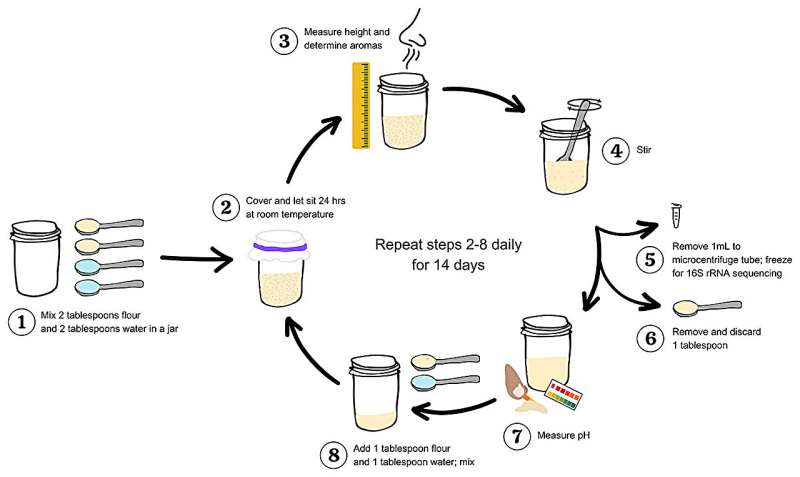This article has been reviewed according to Science X's editorial process and policies. Editors have highlighted the following attributes while ensuring the content's credibility:
fact-checked
peer-reviewed publication
trusted source
proofread
Using different flours for sourdough fosters different bacteria—and flavors

A new study of the microbial ecosystem in sourdough finds that using different types of flour fosters distinct bacterial communities, and that these differences contribute to the variation of sourdough aromas and flavors.
"People bake sourdough all over the world, and our previous research shed light on the tremendous variation in the types of microbes found in sourdough starters, and how those microbes influence the aroma of sourdough and how quickly it rises," says Erin McKenney, corresponding author of the study and an assistant professor of applied ecology at North Carolina State University.
"Our new work focuses on the role that different types of flour play in shaping those microbial ecosystems. As it turns out, the flour bakers use to 'feed' their starters plays a significant role in determining which types of bacteria thrive. And that, in turn, strongly influences the aroma that these sourdoughs produce."
"In other words, our findings show that bakers can influence the aroma of their sourdough by using different flours, because those flours will foster different communities of bacteria."
For the study, researchers developed a protocol designed to reproduce what bakers actually do in their kitchens. The researchers created four sourdough starters using 10 different flours, for a total of 40 starters. The researchers used five flours that included gluten: unbleached all-purpose flour, red turkey wheat, emmer, rye and einkorn; and five gluten-free flours: teff, millet, sorghum, buckwheat and amaranth. The 40 starters were kept in the same growing environment and were fed once a day for 14 days.
The researchers collected data from each starter daily. This included measuring pH and height, as well as recording the aromas produced by each starter. The researchers also took samples of the starters for DNA sequencing, in order to determine the diversity and abundance of bacteria in each sample.
"We found that the starters started out being fairly similar to each other, but that changed substantially over time," McKenney says. "Over the course of the 14 days, we found that each type of flour formed increasingly distinct microbial communities. Essentially, it appears that different types of bacteria are able to make the most of the nutritional compounds found in different types of flour."
And when you have different bacterial communities thriving on different nutritional inputs, you get a wide variety of metabolic outputs. In other words, different bacteria produce different smells.
"For example, the bacterial community in amaranth sourdough produces an aroma that smells almost exactly like ham," McKenney says. "I've never smelled a sourdough that had such a meaty aroma. Rye produces a fruity aroma, buckwheat has an earthy smell, and so on. There's a tremendous amount of variation."
There were also a couple surprises.
"One surprise was that rye flour fostered a much wider diversity of bacteria than any other type of flour," McKenney says. "We found more than 30 types of bacteria in the rye starters at maturity. The next highest was buckwheat, which had 22 types of bacteria. All of the other flours had between three and 14."
The researchers also found that seven of the 10 flours produced starters that included high levels of bacteria which produce acetic acid. Only starters made using teff, amaranth and buckwheat were lacking the acetic acid bacteria.
"These acetic acid-producing bacteria made up between 12.6% and 45.8% of the bacteria in the starters from those seven flours," McKenney says. "So it's playing a significant role in those microbial ecosystems. This is surprising because we didn't even know this type of bacteria was found in sourdough until 2020. Our previous work found that it was not uncommon, but to see it at such high levels, across so many types of flour, was definitely interesting."
And while all of this is scientifically compelling, it also offers some practical insights for sourdough bakers.
"This study offers insights into how bakers can modify the flour they're using in their starters to get the aromas and flavors they're looking for," McKenney says. "We also found that the starters took 10 days to become 'functionally mature,' or ready for baking. And that's useful for bakers to know, too."
The paper, "Sourdough Starters Exhibit Similar Succession Patterns But Develop Flour-Specific Climax Communities," is published in journal PeerJ.
More information: Erin A. McKenney et al, Sourdough starters exhibit similar succession patterns but develop flour-specific climax communities, PeerJ (2023). DOI: 10.7717/peerj.16163
Journal information: PeerJ
Provided by North Carolina State University


















